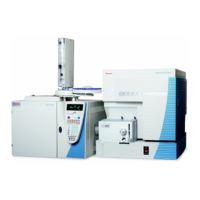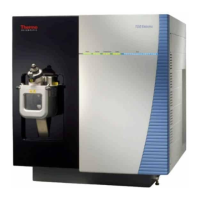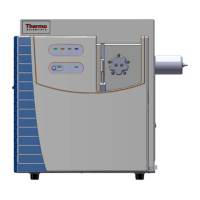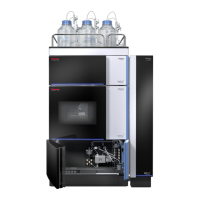Glossary: collision-induced dissociation (CID)
88 TSQ Endura and TSQ Quantiva Hardware Manual Thermo Scientific
collision-induced dissociation (CID) A method of
fragmentation where ions are accelerated to high-
kinetic energy and then allowed to collide with
neutral gas molecules such as helium or nitrogen.
The collisions break the bonds and fragment the ions
into smaller pieces.
contact closure connection The cable connection is
from the external peripheral device to the mass
spectrometer contact closure pins (Start In and
Ground). The external device sends the contact
closure (start) signal to the mass spectrometer.
conversion dynode A highly polished metal surface
that converts ions from the mass analyzer into
secondary particles, which enter the electron
multiplier.
D
divert/inject valve A valve on the mass spectrometer
that can be plumbed as a divert valve or as a loop
injector.
E
electron multiplier A device used for current
amplification through the secondary emission of
electrons. Electron multipliers can have a discrete
dynode or a continuous dynode.
electrospray (ESI) A type of atmospheric pressure
ionization that is currently the softest ionization
technique available to transform ions in solution into
ions in the gas phase.
F
flow rate, syringe pump status The syringe pump
injection flow rate in milliliters per minute (mL/min)
or microliters per minute (μL/min) for the current
sample, as defined in the current experiment method.
forepump The pump that evacuates the foreline. A
rotary-vane pump is a type of forepump. It might
also be referred to as a backing, mechanical, rotary-
vane, roughing, or vacuum pump.
fragment ion A charged dissociation product of an
ionic fragmentation. Such an ion can dissociate
further to form other charged molecular or atomic
species of successively lower formula weights.
full-scan type Provides a full mass spectrum within a
defined mass range.
H
heated-electrospray (H-ESI) Converts ions in
solution into ions in the gas phase by using
electrospray (ESI) in combination with heated
auxiliary gas.
I
image current detection The detection of ion motion
by the charge (current) induced on one or more
capacitive plates (outer electrodes).
ion detection system A high sensitivity, off-axis
system for detecting ions. It produces a high signal-
to-noise ratio (S/N) and allows for switching of the
voltage polarity between positive ion and negative
ion modes of operation. The ion detection system
includes two ±12 kVdc conversion dynodes and a
discrete dynode electron multiplier.
ion isolation A step in the quadrupole Q1 mass
analysis where the mass analyzer ejects all ions except
for the ions of interest.
ion isolation waveform voltage A waveform applied
to the linear ion trap that ejects all ions except the
SIM ion or precursor ion.
ion optics Focuses and transmits ions from the API
source to the mass analyzer.
ion polarity mode The mass spectrometer can operate
in either of two ion polarity modes: positive or
negative.
ion sweep cone A removable cone-shaped metal cover
that fits on top of the API ion transfer tube and acts
as a physical barrier to protect the entrance of the
tube.

